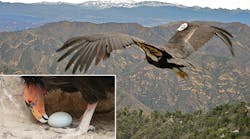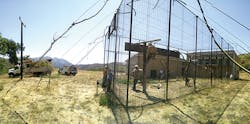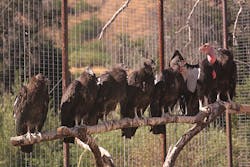With wings sometimes spanning nearly 10 ft, California condors are the largest flying birds in North America. They can soar as high as 15,000 ft and as fast as 55 mph, and they sometimes travel 150 miles a day in search of a meal. But, with a rapidly declining population, condors were also headed for extinction in the 1980s.
In a bid to save them, the U.S. Fish & Wildlife Service and its partners launched the California Condor Recovery Program in 1982, taking the last one into captivity in 1987. Now, instead of only 22 in 1987, there are 437 condors in the U.S. Those include 232 condors in the wild — 131 in California, 72 in Arizona/Utah and 29 in Baja California, Mexico — and 205 still in captivity in the program. Of those, there are 68 condors and three chicks flying free in Southern California.
One of the leading successes in achieving these numbers is power pole aversion training, especially since perching on power poles (along with lead poisoning and microtrash) is the leading threat to condors. To help protect the condors, releases have been moved to areas with fewer power lines, and utilities have relocated some power lines underground or encased overhead lines in insulated tree wire, which improves visibility to condors.
Preventing Avian Fatalities
In 1994, the Wildlife Service started the aversion training over concerns about electrocutions, fatal collisions and power pole perchings following the reintroduction of captive-bred condors in 1992. As part of the training, it placed a replica of a power pole in the birds’ flight pens.
This pole is designed to deliver a mild but uncomfortable electric shock to condors that land on its crossarm. In turn, the condors then associate power poles with danger and avoid them. To reinforce this, natural tree snags are placed nearby to reward condors that land on them with a positive perch and, best of all, no shock.
No captive-bred condor has been electrocuted while perched on a power pole since the training’s inception. Also, only one condor in Southern California has died in a mid-air collision with a power line, and that incident happened back in 2001, according to the Wildlife Service, which tracks the birds by transmitters and ID numbers attached to their wings.
“I think it’s a great aversion training technique,” says Josh Felch, a biological science technician with the U.S. Fish & Wildlife Service. “A mild shock is much better than possible injury and likely death associated with condors perching on active power poles.”
Setting Aversion Poles
To take its aversion training to the next level, Southern California Edison’s (SCE’s) avian protection program and transmission and distribution unit partnered with the Wildlife Service. After installing smaller aversion poles in the wild, they recently set more realistic-sized 30-ft aversion poles near flight pens at Bitter Creek National Wildlife Refuge and Hopper Mountain National Wildlife Refuge.
On consecutive days, Felch, SCE biologists Rachael Poston and Jeff Trow, and utility field supervisor Mark Hubbard oversaw a line crew of Daniel Ocegueda, Joel Garibay and Julian Macias to set the hot-wired poles, which are powered by a 12-V electric fence charger popular in the agricultural industry.
The chicks fledged in the wild do not get this training. This is where the 30-ft SCE poles installed just outside the release site flight pens come in.
“It is [chicks fledged in the wild] that we are targeting, as well as follow-up training for the other condors in the free-flying populations, with the establishment of these new mock power poles,” Felch says.
Releasing Condors
The condors’ journey from breeding location to re-introduction begins at one of four captive breeding facilities: the Los Angeles Zoo, the San Diego Zoo Safari Park, the Peregrine Fund’s World Center for Birds of Prey in Idaho and the Oregon Zoo, where the birds are first introduced to pole aversion training.
From captive-breeding facilities, condors are taken to release location flight pens — Bitter Creek and Hopper Mountain are two of five and also include replica poles — where they can acclimate to their new surroundings and interact with condors perching or feeding nearby.
When condors are released, typically in the fall and at about 18 months old, they are freed in pairs to encourage socialization. Supplemental carrion — the staple of their diet — is placed near the release pen to lure other free-flying condors in to feed and interact with the new releases.
Of course, the new 30-ft aversion pole is nearby to assist the recovery plan’s goal of establishing two geographically distinct, self-sustaining populations, each with 150 birds in the wild and at least 15 breeding pairs, with a third population of condors retained in captivity.
While Felch is pleased with the progress, he cautions that these numbers merely give California condors, which can live for 40 years or more, a chance to be downlisted from endangered to threatened under the Endangered Species Act. However, delisting the condor from the endangered and threatened lists is the ultimate goal and there is still work to be done there.
Senior SCE biologist Kara Donohue loves that SCE is part of this work. “These are the types of projects where Edison gets to take a break from its regular work and provide assistance to one of our partners that benefits both of us. It’s always great to get a chance to be involved in the preservation of an endangered species like the California condor.”
Paul Netter (edison.newsroom.com) works in media relations for Southern California Edison in Rosemead, California.




